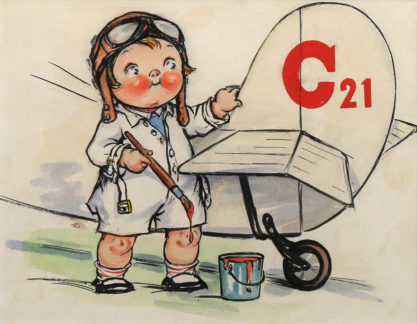

This 1930s original artwork comes from a collection of published Campbell’s Soup Kids illustrations unearthed in a Connecticut estate. The Campbell’s Soup Kids appeared in print ads in countless American mainstream publications such as The Saturday Evening Post.
In this offering a Dolly Dingle character Campbell’s Soup Kid is putting the finishing touches on his or her soapbox derby bi-plane early aviation age-inspired racing car. Nicely matted and framed behind glass and ready to hang.
Along with Cream of Wheat and Coca-Cola, Campbell’s created some of the most iconic and duplicated advertising campaigns in twentieth century American advertising history. By the 1930s Campbell’s Soup had a stable of illustrators that worked very closely in the style Grace Drayton developed for the Campbell’s Soup Kids characters. It is unknown whether this is by the hand of Grace Drayton or another American illustrator. A fresh Connecticut estate find and guaranteed to be an original published Campbell’s Soup illustration painting.


 |
| Above: Verso view |
The Campbell Kids have been selling Campbell’s Soup since 1904 when Grace Wiederseim Drayton, an illustrator and writer, added some sketches of children to her husband’s advertising layout for a Campbell’s condensed soup. The Campbell advertising agents loved the child appeal and choose Mrs. Wiederseim’s sketches as trademarks. In the beginning, Campbell Kids were drawn as ordinary boys and girls, later, Campbell Kids took on the personas of policemen, sailors, soldiers, and other professions.
Grace Wiederseim Drayton will always be the “mother” of Campbell Kids. She drew for the company advertising for nearly twenty years. Drayton’s designs were so popular that doll makers wanted to capitalized on their popularity. Campbell’s gave the E. I. Horsemen Company the license to market dolls with the Campbell label on their sleeves. Horseman even secured two U.S. design patents for the dolls’ clothes.
 |
| Above: Andy Warhol’s Campbell’s Soup Montage; Museum of Modern Art, NYC |
Today, Campbell’s Soup Company, with its famous red and white label, remains a staple in the kitchen as well as American culture.
